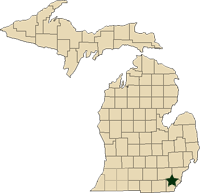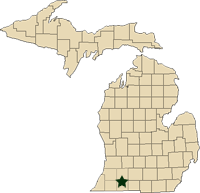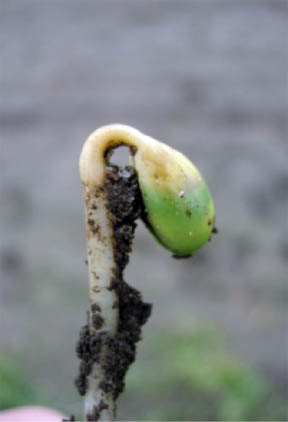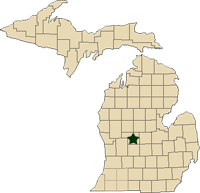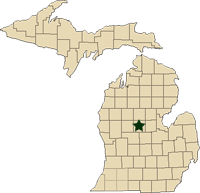Regional Reports on Michigan Field Crops – May 19, 2011
MSU Extension educators’ pest and field crop updates for Michigan.
This week’s regional reports:
- Southeast Michigan – Ned Birkey
- Southwest Michigan – Bruce Mackellar
- West Central Michigan – Fred Springborn
- Central Michigan – Paul Gross
Southeast Michigan – Ned Birkey, Michigan State University Extension
|
Weather has been cool, except for the 87°F of May 12 and 80°F of May 13, with rains starting last Friday (May 13) and continuing every day.Toledo, Ohio, weather reports that this area has had above normal precipitation every month of 2011, totaling about 18 inches so far, which is about 6 inches above normal.
Alfalfa is approaching the one-tenth bloom stage and will be cut whenever the sun comes out and the crop and soils dry out. Growth has been great, so we could have a very good first cutting. Alfalfa weevil feeding continues, with some weevils getting diseases, but the good growing conditions have allowed plants to recover. I have not seen any potato leafhoppers yet,though temperatures were 87°F a week ago today and it is possible they blew in on that front.
Corn planting has been halted all week. I should say about one-third to one-half of the corn acreage has been planted, with a few fields spiking through.
Soybean planting has also been halted. Perhaps 20 percent of the soybeans have been planted. The soybean aphid suction trap is up and running,with the first sample mailed to Dr. Dave Voegtlin at the University of Illinois last week.
Wheat is at Feekes’ growth stage 8 with flag leaf emergence.Powdery mildew is a problem on susceptible varieties. I anticipate a lot of fungicide spraying for Fusarium head blight because of all the wet weather.Farmers need to protect the flag leaf and flag -1 leaf of diseases for the highest yield potential.
Southwest Michigan – Bruce Mackellar, Michigan State University Extension
|
Despite a great, even if somewhat delayed, start to the 2011 planting season, slow-moving, heavy storms going from south to north dropped a lot of rain over southern Michigan last Friday night (May 13). Soil moisture conditions quickly moved from good to saturated in most areas across southwest Michigan. Temperatures also fell following the thunderstorms over the weekend. Most field operations have ground to a halt waiting for soils to dry out.
Temperatures and GDD accumulations
The normal heat accumulation (Base 50 GDD’s) is around 12per day for the next five days, and then increases to 12.5 per day over the next five. Most Enviro-weather stations are reporting that 150-160 GDD’s Base 50 have accumulated. This means that corn planted on May 1 should be at the V1 Growth Stage. The 6 to 10 day outlook from NOAA has the region near normal in temperature range, shifting to below normal in the 8 to 14 day period.
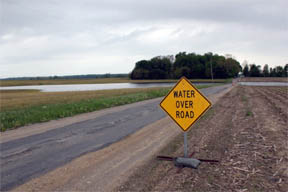 |
Precipitation summary
Precipitation levels over the last seven days have been areal challenge. The majority of the region received between 2 to 4 inches of precipitation, with more falling in Berrien, Allegan and Ottawa counties. Soils have generally been too wet to work until yesterday (May 18) and even though producers were in the fields, it was far from optimal. Perhaps one of the hardest hit areas in the region has been southern Berrien County, where wet conditions have prevented most field operations this spring. In walking through fields there yesterday, it will take at least a week of dry weather to get things moving again. The 6 to 10 day outlook has us in the above normal precipitation zone, as does the 8 to 14. This will bring us into the first week of June.
Alfalfa growth has continued nicely. Canopy height is now in the 12- to 14-inch range. Alfalfa weevil tip is evident but light in most fields I have walked this week. Base 41GDD’s for alfalfa development range from 442 at Fennville to 540’s in Berrien County. We are still quite a way from the optimal cutting date of 750 GDD’s.
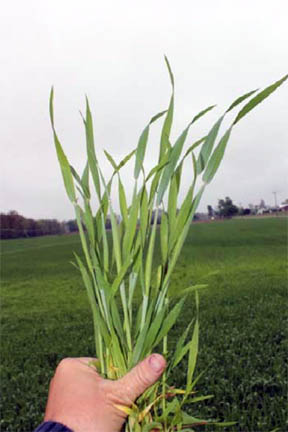 |
Wheat continues to grow rapidly. Fields are mostly in the Boot stage. There is some incidence of powdery mildew in a few of the leaves below the flag leaf on fields that I have walked. Most are less than 5 percent of the leaves examined, with very low percentage of leaf area infected.However, with warm and moist conditions in the forecast, monitoring the top two leaves for this disease may be warranted. There are some areas in fields that appear to have suffered some nitrogen losses from the heavy rainfall over the last several weeks.
Planting has pretty much stopped for both corn and soybeans, except on the coarsest textured soils.Corn planting progress ranges from perhaps 80 percent to almost none depending upon the area. Southern Berrien County may be the furthest behind with very little field activity this spring so far. Corn planted around May 1 is up and at V1. Corn plants that are emerged are somewhat yellow. However, stands have looked good on every field I have checked.While we did have some fields with large ponded areas following last Friday’s intense rainfall event, cooler temperatures should have reduced seedling mortality. Some producers have been working around wet spots to plant the majority of fields. For those areas where planting and field work have been delayed, we may have more challenges on the horizon.
Thick winter annual and cover crops provided an excellent place for black cutworm moths to lay eggs. Producers need to be aware that these fields may have challenges with cutworm larval feeding once field are able to be worked. Most early planted corn has emerged. Herbicide applications are likely to be lagging behind with the wet conditions of late.For more information on delayed pre-emergence weed control options, read MSU’s Department of Crop and Soil Sciences’ Wesley Everman’s article, Delayed preemergence herbicide applications in corn.
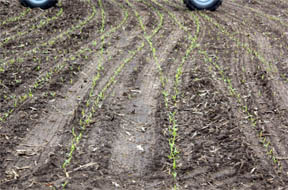 |
It was a good thing that we had the opportunity to complete as much fall tillage as we did last season. Be cautious about planting into too wet conditions. Be on the lookout for signs of sidewall smearing from your planting equipment. Although it is time to go, you still have options to improve seedbed quality with tillage in a few hours given some wind and sunlight.
|
Soybeans planted around the May 1 are at the unifoliate leaf stage.Stands look good, although most of the beans planted were on light sandy ground. While I did not see much evidence of seedling diseases yet, Martin Chilvers, MSU Department of Plant Pathology, did report seeing some signs of herbicide damage and seedling diseases on MSU’s early planted trials near campus. With heavy rainfall on May 13-14, we may have set the stage for dampening off diseases such as Pythium,Rhizoctonia and Phytopthora. Other factors can also contribute to poor seedling growth and emergence. MSU soybean educator Mike Staton also included an article of other challenges that we may see in soybean germination.
As we move forward, we should keep in mind that black cutworm moths may have been brought north from the thunderstorms and been deposited in our area. Heavy winter annual weed infestations make a great location for these moths to lay eggs. ChrisDiFonzo, MSU Department of Entomology, wrote a great article on conditions where cutworms might present a challenge in your fields.
Delayed planting can cause some of the worst stress for producers. It puts everyone in an extreme rush to get things accomplished in the limited time available. Safety is often overlooked in these situations.Taking time to be safe at the farmstead, in the fields and on the road is important to getting the job done. One of the few things that we can do in these times it to make sure that equipment is in top shape to go when conditions are finally right. Get extra common repair items on hand in anticipation of common equipment problems so that you can fix things on the fly. Ultimately, we cannot change the weather, we can only prepare to do our best when things dry out.
West Central Michigan – Fred Springborn, Michigan State University Extension
|
Wet weather continues in much of the west central region,hindering and delaying field work in many areas. The Montcalm Experiment Farm received over 1inch of rain Friday evening (May 13) with an additional 0.25 of an inch over the weekend. Standing water is common in low areas of fields, even on the sandier soils. Low soil temperatures are in the low to mid-50s. High air temperatures have ranged from the mid-50s Sunday and Monday to the mid-80s on last Thursday and Friday.
Early planted corn is emerging. Much of this emerged corn is quite yellow due to the general lack of sunshine and predominantly cool temperatures, not a lack of mineral nutrients. Overall, only 25 to 35 percent of corn is planted and a few growers are nearly finished planting, but many more have very little planted.
Alfalfa is growing quite well with many fields at 18 to 20 inches in height. Very little alfalfa weevil or damage has been observed.
Wheat is predominantly at Feekes’ stage 7 and quite variable. Several fields have alternating strips of darker and lighter green. In many but not all cases,these alternating strips can be attributed to the nitrogen application. Disease pressure is quite low in most varieties and powdery mildew is commonly observed low in the canopy on highly susceptible varieties.
Rye is in boot and heading out.
There has been very little soybean planting.
Potato planting is approximately 30 to 40 percent complete. Soil compaction issues are likely in many fields.
Central Michigan – Paul Gross, Michigan State University Extension
|
Weather
There were four days that were suitable for field work across the region this week. The southern part of the region received over 4 inches of rain while the northern parts were more fortunate, receiving only about an inch. Fields are saturated and it will take a week of good drying weather before planting can continue.Farmers are reporting that they have not planted a single field in good conditions so far this year.
Commodity reports
Planting progress has corn at about 40 percent and soybeans at about 15 percent across the region this week. The early planted corn emerged this week. Weeds are taking over fields and will cause problems if not managed. Early planted soybeans are just pushing through.
The wheat crop is in Feekes’ growth stage7. Stands are variable with some excellent and others yellow and uneven.Farmers are still trying to make nitrogen and herbicide applications. Some powdery mildew has been reported low on the plant. Scout fields for insects and diseases. Flights of black cutworm and army worm moths have occurred, so monitor fields for these pests. Monitor fields for growth stage if you are planning fungicide applications. Timing is critical for fungicides to be effective.
The alfalfa crop is about 20 inches tall with a PEAQ of 31 NDF. No tip feeding from alfalfa weevil reported at this time. Monitor fields for this pest. It appears the crop will be ready to harvest before farmers are ready to harvest due to the wet spring.
The oats and barley crops are planted with most of the fields emerged. Stands are generally good. The alfalfa seedings planted with oats are doing very good.Weed control will be necessary as soon as field conditions allow.
Sugarbeets are nearly all planted. There have been some emergence problems reported.



 Print
Print Email
Email